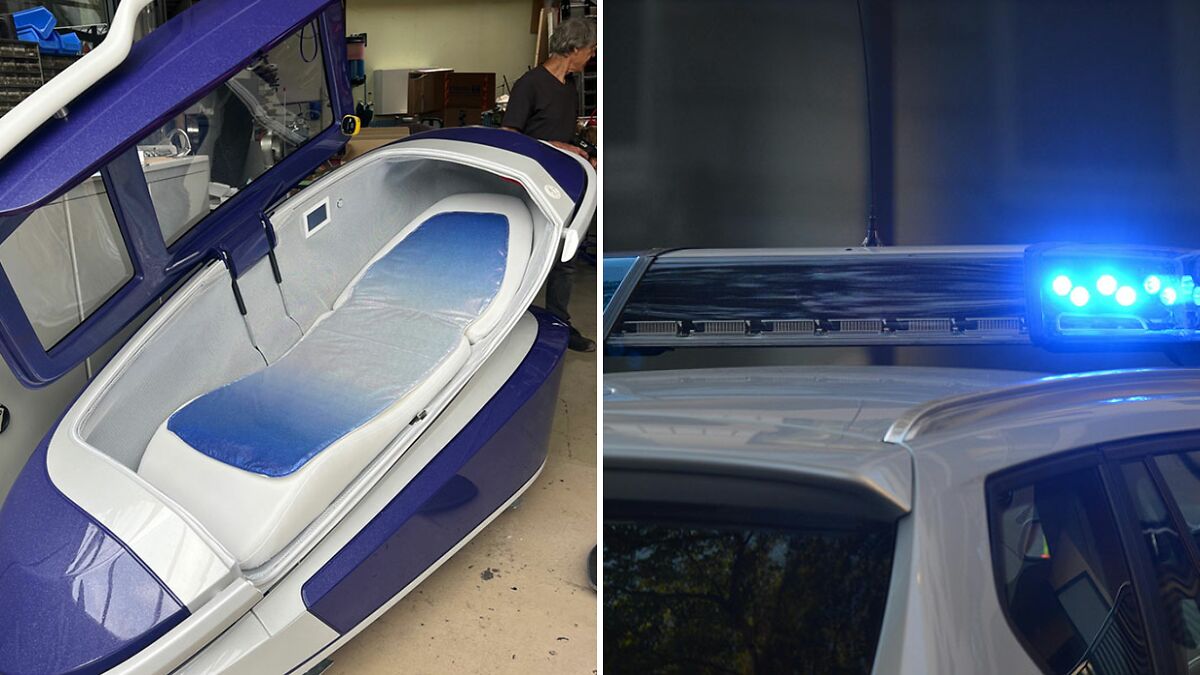
Police Makes Arrests After “Euthanasia Pod” Is Used For The First Time, Device Gets Confiscated
Swiss police confiscated a controversial “Sarco” euthanasia pod after a person died using it for the first time. The incident reportedly took place on Monday (September 23) afternoon near a cabin in a forest in the municipality of Merishausen, in Schaffhausen canton, in Switzerland.
The police and the Public Prosecutor’s Office of Schaffhausen intervened at the scene and confiscated the capsule.
- Swiss police confiscated the first-used Sarco euthanasia pod; a body was sent for autopsy.
- A handful of people were arrested as Swiss authorities investigate incitement.
- Sarco pod releases nitrogen to induce painless death; inventor is Dr. Philip Nitschke.
- Sarco is not compliant with Swiss safety laws; use of nitrogen ruled out by Health Minister.
The body was transported to the Zurich Institute of Forensic Medicine for an autopsy, Swiss outlet 20 Minutes reported on Tuesday (September 24).
According to local reports, a handful of people were arrested, including a Dutch photojournalist, as per the NL Times.
and the Public Prosecutor’s Office of the canton of Schaffhausen has opened a criminal investigation against the suspects for incitement and assistance in suicide, French Swiss outlet RTS reported on Tuesday.
Swiss police confiscated a controversial “Sarco” euthanasia pod
Image credits: Pixabay
To use the Sarco capsule, also known internationally as the “euthanasia pod,” the person wishing to die presses a button.
A large amount of nitrogen is then released, displacing the oxygen. The person loses consciousness after a few breaths of nitrogen and dies after about five minutes, according to the capsule’s inventor, Australian doctor Philip Nitschke.
While assisted suicide is legal in Switzerland, public prosecutors from several cantons, including Schaffhausen, announced over the summer that they would open a criminal investigation if the capsule is used in their jurisdiction, as per RTS.
Moreover, the Sarco suicide capsule does not comply with the law, Health Minister Elisabeth Baume-Schneider reportedly said during the National Assembly’s question hour on Monday.
Multiple people were arrested, including a Dutch photojournalist
Image credits: thelastresort
The capsule does not meet the requirements of product safety legislation and therefore cannot be marketed, the minister explained.
Additionally, the use of nitrogen in the capsule is not compatible with the purpose article of the Chemicals Act in Switzerland, Baume-Schneider said. Jurisdiction must be clarified on a case-by-case basis, the federal councilor reportedly added.
The Sarco pod was brought to public attention earlier this month, after a British couple signed up to use it.
A person died using the pod for the first time
Image credits: thelastresort
Peter Scott, a former Royal Air Force (RAF) engineer, and his wife, former nurse Christine Scott, have been married for 46 years and reportedly decided to end their lives together in Switzerland.
Christine, who is 80 years old, was diagnosed with early-stage vascular dementia. Vascular dementia is a condition that affects the brain, causing problems with thinking, memory, and behavior, the National Institute of Aging explains.
As a result of the heartbreaking diagnosis, the couple wants to travel to Switzerland to die in each other’s arms in the death capsule – known as the Sarco – to mark the end of their long and happy marriage, The Daily Mail reported September 7.
Image credits: thelastresort
Named “Sarco” (for sarcophagus), the box reportedly allows a person to die by suicide without outside help. Inside, the candidate for voluntary death simply presses a button, releasing nitrogen.
The saturation of nitrogen causes the individual to lose consciousness due to lack of oxygen, followed by a painless death in a matter of seconds.
The method reportedly requires no poison to be swallowed or injected into the veins. And because the materials “Sarco” is made of are biodegradable, it can also be used as a coffin.
The incident reportedly took place on Monday (September 23) afternoon
Image credits: Markus Spiske
As of 2023, euthanasia is legal in Belgium, Canada, Colombia, Luxembourg, the Netherlands, New Zealand, Portugal (law not yet in force, awaiting regulation), Spain, and all six states of Australia.
Moreover, assisted suicide is legal in Austria, Belgium, Canada, Germany, Luxembourg, the Netherlands, New Zealand, Portugal, Spain, Switzerland, parts of the United States, and all six states of Australia.
The legal frame for a person’s right to choose to end their life has evolved in other countries.
In Peru, human rights advocate and lawyer Josefina Miró Quesada Gayoso helped secure exceptional euthanasia approval for a woman for the first time ever in the Latin country.
Poll Question
What are your thoughts on the use of the 'Sarco' euthanasia pod for assisted suicide?
Support its use
Oppose its use
Undecided
Need more information
Having assisted suicide be legal and available takes some of my fear of bodily infirmity away. Being utterly incapable of ending myself if I'm suffering is terrifying. I imagine lying in bed, fed through a tube, incapable of so much as picking up a tv remote or reading a book and unable to even starve myself because my autonomy is utterly gone. Dreadful thought.
It is kind of strange that with a device that has multiple ethical and legal implications, it all comes down to product regulations... The device is not illegal there because of its function, but because of technical nonconformity with product safety and chemical laws. Although I am not sure how relevant "product safety" is for a suicide device.
Right? That was my first thought when reading that above. Product 'safety' is a bit of a stretch considering its intended use.
Load More Replies...I assume that, if they were ever to make it legal, they would need to make sure the ‘Sarco’ meets product safety standards so that it can’t accidentally leak the nitrogen and affect those OUTSIDE of it (in other words, any operators and others present), instead of just affecting the willing person inside of it. I also assume they’d need a way to stop the flow of nitrogen quickly and regulate oxygen back in, along with an emergency latch to get out, in the case that the person who wanted to die abruptly had a realisation that they didn’t want to do it after all.
I think the concern is about dignity and lack of suffering. As the person loses consciousness in a matter of seconds, the user has no real chance to change their mind after pressing the button.
I doubt that you lose consciousness within seconds of pressing the button. (Never held your breath before?)
There's a bit more to it than that. With the way the device is designed, there's no "second thoughts" allowance with the system. Meaning that after activating the process, there's no point where a person can decide to not carry through with the suicide. The Sarco pod locks once the process starts, and doesn't unlock until after a set amount of time. So, say someone activates it, and then has second thoughts about the process, it can't be opened from the outside to vent the gas or aid in the person getting out of it. With the approved processes in Switzerland, there's an antidote for the medicine used, which in the event that a person has second thoughts, can be administered to counter-act the process and prevent death.
First, safety is about everyone, not just the person inside the pod. Second, using gas to kill someone is a touchy subject, even if the gas is nitrogen and the person is willing. Third, what happens if the suicide fails? What are the consequences for the person who intended suicide ? If they are left brain-damaged due to lack of oxygen, are they kept alive because they can't consent to assisted suicide anymore ?
I like the idea of a person being able to choose the time of their death, and doing it in a safe controlled way, without pain. However, I'd want it in a controlled setting and access being possible only by meeting certain criteria.
Oh, do tell me the criteria upon which I do not have complete ownership of my body.
Load More Replies...Scott Rackley, it very much depends on the country in which you reside. There are many places where you most definitely DO NOT have the right to decide when your life should come to an end. But, getting to the root of your question, I would want strong, agreed on criteria when it comes to others assisting in being another person's life to an end. This is to ensure the person is not being pressured into the decision by family members, or because they are feeling low, dysregulated, or are making an impetuous decision. Having the established criteria protects the people assisting, and it also helps the person to fully explore their options before making a decision.
That's cool, I would want you to keep your nose out of it. Since, you know, it's none of your business.
Why should someone (koff, koff, right wing extremists), demand that someone be kept alive when it’s no longer a feasible option? It just makes me SO mad! I’m grateful for DNR clauses and such, but folks also need to understand that the human body is not infinite.
I read another article, recently, written ahead of time by a US woman who took her life in Switzerland, legally. It cost her some 10,000 just to the company. So I'm thinking more than being illegal for regulations, it is, as usual, about profit and who profits from the death.
yes. i cannot understand the reasoning of the man. i would not like it if my wife, who was "not dying" did it with me
The issue the Swiss, and multiple other places have with the "Sarco" pod, lies in its overall design. Specifically, there's no 'second thoughts' override for the process once it starts. Basically, this means that once a person pushes the button, the pod locks its door (Sarco claims this is to aid in keeping the gas sealed inside the pod), and prevents that door from being opened until after a set amount of time has passed. In the event that a person, after pushing the button, changes their mind about suicide, there's no fail-safe to get the person out of it before the cycle completes. With existing assisted suicide methods, there's a counter-agent that can be administered to prevent death from taking place due to the medicine that is administered.
Gotta appreciate the irony that this product (whose intended function is to induce death) is not compliant with "health and safety" regulations.
No irony there, toxic gas is used and the idea is that the person inside dies as peacefully as possible PLUS the gas shouldn't leak and endanger other people outside of the product
Load More Replies...Is t the whole point of the Sarco to die? So if it killed someone, it worked?
You cant kill yourself, Goverment need you to be alive to pay taxes and mek money for parasites, so its crime to end your own life, your life donest belong to you. They rather be happy when you jump of the bridge and splash yourself after 50m fall then let you go without pain and fear... that disgusting.
My question is would you rather arrive at a pod with a gurney or arrive at a sidewalk with a shovel?
Locally, Dr. Jack Kervorkian was a proponent for assisted suicide. He used to come in to our restaurant wearing a light blue cardigan and we knew someone was getting help that night - it was his unofficial uniform, we thought. He was arrested numerous times, but it has changed the conversation on euthanasia in a good direction. I have a degenerative neuromuscular disease and know there is a point and time I may want the right to not suffer anymore.
Having assisted suicide be legal and available takes some of my fear of bodily infirmity away. Being utterly incapable of ending myself if I'm suffering is terrifying. I imagine lying in bed, fed through a tube, incapable of so much as picking up a tv remote or reading a book and unable to even starve myself because my autonomy is utterly gone. Dreadful thought.
It is kind of strange that with a device that has multiple ethical and legal implications, it all comes down to product regulations... The device is not illegal there because of its function, but because of technical nonconformity with product safety and chemical laws. Although I am not sure how relevant "product safety" is for a suicide device.
Right? That was my first thought when reading that above. Product 'safety' is a bit of a stretch considering its intended use.
Load More Replies...I assume that, if they were ever to make it legal, they would need to make sure the ‘Sarco’ meets product safety standards so that it can’t accidentally leak the nitrogen and affect those OUTSIDE of it (in other words, any operators and others present), instead of just affecting the willing person inside of it. I also assume they’d need a way to stop the flow of nitrogen quickly and regulate oxygen back in, along with an emergency latch to get out, in the case that the person who wanted to die abruptly had a realisation that they didn’t want to do it after all.
I think the concern is about dignity and lack of suffering. As the person loses consciousness in a matter of seconds, the user has no real chance to change their mind after pressing the button.
I doubt that you lose consciousness within seconds of pressing the button. (Never held your breath before?)
There's a bit more to it than that. With the way the device is designed, there's no "second thoughts" allowance with the system. Meaning that after activating the process, there's no point where a person can decide to not carry through with the suicide. The Sarco pod locks once the process starts, and doesn't unlock until after a set amount of time. So, say someone activates it, and then has second thoughts about the process, it can't be opened from the outside to vent the gas or aid in the person getting out of it. With the approved processes in Switzerland, there's an antidote for the medicine used, which in the event that a person has second thoughts, can be administered to counter-act the process and prevent death.
First, safety is about everyone, not just the person inside the pod. Second, using gas to kill someone is a touchy subject, even if the gas is nitrogen and the person is willing. Third, what happens if the suicide fails? What are the consequences for the person who intended suicide ? If they are left brain-damaged due to lack of oxygen, are they kept alive because they can't consent to assisted suicide anymore ?
I like the idea of a person being able to choose the time of their death, and doing it in a safe controlled way, without pain. However, I'd want it in a controlled setting and access being possible only by meeting certain criteria.
Oh, do tell me the criteria upon which I do not have complete ownership of my body.
Load More Replies...Scott Rackley, it very much depends on the country in which you reside. There are many places where you most definitely DO NOT have the right to decide when your life should come to an end. But, getting to the root of your question, I would want strong, agreed on criteria when it comes to others assisting in being another person's life to an end. This is to ensure the person is not being pressured into the decision by family members, or because they are feeling low, dysregulated, or are making an impetuous decision. Having the established criteria protects the people assisting, and it also helps the person to fully explore their options before making a decision.
That's cool, I would want you to keep your nose out of it. Since, you know, it's none of your business.
Why should someone (koff, koff, right wing extremists), demand that someone be kept alive when it’s no longer a feasible option? It just makes me SO mad! I’m grateful for DNR clauses and such, but folks also need to understand that the human body is not infinite.
I read another article, recently, written ahead of time by a US woman who took her life in Switzerland, legally. It cost her some 10,000 just to the company. So I'm thinking more than being illegal for regulations, it is, as usual, about profit and who profits from the death.
yes. i cannot understand the reasoning of the man. i would not like it if my wife, who was "not dying" did it with me
The issue the Swiss, and multiple other places have with the "Sarco" pod, lies in its overall design. Specifically, there's no 'second thoughts' override for the process once it starts. Basically, this means that once a person pushes the button, the pod locks its door (Sarco claims this is to aid in keeping the gas sealed inside the pod), and prevents that door from being opened until after a set amount of time has passed. In the event that a person, after pushing the button, changes their mind about suicide, there's no fail-safe to get the person out of it before the cycle completes. With existing assisted suicide methods, there's a counter-agent that can be administered to prevent death from taking place due to the medicine that is administered.
Gotta appreciate the irony that this product (whose intended function is to induce death) is not compliant with "health and safety" regulations.
No irony there, toxic gas is used and the idea is that the person inside dies as peacefully as possible PLUS the gas shouldn't leak and endanger other people outside of the product
Load More Replies...Is t the whole point of the Sarco to die? So if it killed someone, it worked?
You cant kill yourself, Goverment need you to be alive to pay taxes and mek money for parasites, so its crime to end your own life, your life donest belong to you. They rather be happy when you jump of the bridge and splash yourself after 50m fall then let you go without pain and fear... that disgusting.
My question is would you rather arrive at a pod with a gurney or arrive at a sidewalk with a shovel?
Locally, Dr. Jack Kervorkian was a proponent for assisted suicide. He used to come in to our restaurant wearing a light blue cardigan and we knew someone was getting help that night - it was his unofficial uniform, we thought. He was arrested numerous times, but it has changed the conversation on euthanasia in a good direction. I have a degenerative neuromuscular disease and know there is a point and time I may want the right to not suffer anymore.

 Dark Mode
Dark Mode 

 No fees, cancel anytime
No fees, cancel anytime 





















































35
34